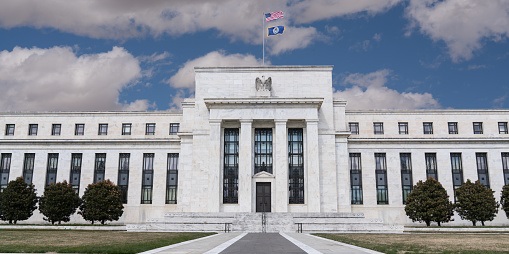It has been a quiet start to the week for Europe equity markets, with a number of mainland stock markets closed amid public holidays. The Stoxx 600 index is this morning trading roughly flat, though remains not too far from recent all-time high levels around 446. Analysts argue that the improving pandemic situation on the continent is supportive for risk assets there; “The euro zone and the UK are starting to boom as their economies reopen… Falling hospitalisations, declining fatalities, faster vaccinations and easing lockdowns are all helping confidence to recover rapidly across Europe” argues Bank of Singapore chief economist Mansoor Mohi-uddin. Newswires are also citing recent dovish commentary from ECB President Christine Lagarde, who last Friday said that it is still too early for the ECB to discuss winding down its EUR 1.85T PEPP (QE) programme as supportive for stocks. Certainly, these comments seem to have halted the recent rise in Eurozone bond yields; German 10Y yields, which slipped back under -0.1% at the end of last week remain subdued around the -0.13% mark for now, but that is still only about 6/7bps from recent near-two-year highs. Many analysts suspect that Eurozone bond yields will see further upside in tandem with Eurozone stocks in the months ahead, however, reflecting the brighter economic outlook.
Turning to US pre-market trade; things are constructive with the major US equity index futures higher across the board. E-mini S&P 500 futures currently trade around in the upper 4100s, up about half a percent on the week thus far, though some offers ahead of 4200 appear to be acting as resistance for the time being. Nasdaq 100 futures are up about 0.7%, aided by slight drop in US bond yields this AM; 10-year yields are down about a bps and a half to under 1.62%, but broadly speaking conditions in US bond markets are for the moment subdued. US markets are likely to liven up towards the end of the week with Core PCE (the Fed’s favour inflation gauge) and Personal Income and Spending data out on Friday.
Turning to commodities; crude oil prices continue to rise, supported amid continued confidence amongst analysts that the path of least resistance for the crude complex remains to the upside, even if the US and Iran return to the JCPOA nuclear deal and the latter is as a result permitted to drastically increase oil production; Goldman Sachs analysts argue that Even with a potential restart of Iran exports, the case for higher oil prices remains intact despite the potential restart of Iranian crude given the expected vaccine-driven increase in global demand. The bank “estimates that Brent prices would still reach $80 per barrel in fourth quarter, 2021, with our new base case for an October restart (in Iranian output) still supporting our $80 per barrel forecast for this summer”. With regards to the progress towards a deal, reports have been mixed; the latest news suggests that Iran and the International Atomic Energy Agency (IAEA) have agreed a one-month extension on the latter’s monitoring access over nuclear activity in Iran, something which is said to be key for the US and Iran to be able to finalise a deal on returning to the JCPOA. However, over the weekend, US Secretary of State Blinken reportedly said that there was no sign yet from Iran that it is willing to comply with nuclear commitments needed to lift sanctions, which goes against what the Iranian President said last week about the US being ready to lift sanctions, something which weighed on crude oil prices at the time. Still, most analysts suspect a deal is close and this seems to have been priced into crude oil markets at this point.
Elsewhere, in terms of industrial metals, further downside is being seen across the likes of iron ore and copper markets. Chinese iron ore future for delivery in September (the most actively traded iron ore contract on the Dalian Commodity Exchange) dropped 5.2% on the day. Meanwhile, Chinese copper futures were down 1.4%. Downside in Chinese industrial metal markets (remember that China is the world’s foremost consumer of these materials as the country continues to urbanise) continues in wake of last week’s threats from Chinese officials to increase regulatory scrutiny over raw material markets to prevent “unreasonable” jumps in prices. “The rally in copper and iron ore appears to have stalled as investors become increasingly concerned about regulatory constraints and easing stimulus measures” argues analysts at ANZ.
Finally, gold prices continue to trade with a positive bias, and is back in the $1880s, up about 0.3% this morning amid a slightly softer USD and slightly lower US bond yields. A combination of bullish factors has helped push gold prices to more than four-month highs in recent weeks, including inflation concerns, continued dovishness from the Fed, weakness in crypto assets, as well as ongoing weakness in USD and US real yields. Margaret Yang, a strategist at DailyFX, argues that “the US dollar index remains relatively weak and the manufacturing and service PMI’s from the United States and Europe actually raised the prospect of inflation in months to come… (the) recent slide in cryptocurrencies also boosted the appeal of gold as an alternative investment asset. Gold’s upward momentum is very strong and it is likely to challenge a key psychological level at $1,900 in the days to come”. Meanwhile, Michael Hsueh, commodities & FX strategist at Deutsche Bank, argues that “the recent mix of strong U.S. CPI, weak employment, and Fed policymakers willing to let inflation overshoot while targeting the employment gap, could remain gold-bullish for a while longer… Gold’s recovery has been associated with the strong rally in some parts of the commodities complex, increasingly represented by agriculture, metals and transport indices this year, and an eight-year high in US 10-year inflation expectations”.
Finishing up with a look across FX markets; the US dollar is a little weaker this morning with the DXY currently trading back below 90.00 but remaining within the bounds of the recent 89.70-90.20 range set towards the end of last week. Price action across risk assets such as stocks and commodities (excluding Chinese industrial metal prices) remain constructive and bond yields remain subdued, and if this remains the case over the coming days, this ought to continue to weigh on the dollar. Moreover, a large number of Fed members will be orating this week; the Fed’s current stance, which emphasises that it is looking through a “transitory” rise in inflation as it focuses more on its employment goal and that it is not yet time to taper asset purchases has been damaging for the dollar and if Fed speakers stick to this line this week, this is likely to remain the case.
As for the other G10 currencies, things are mixed and choppy this morning with no clear risk bias as of yet. For example, the two outperforming currencies this morning are the euro and NOK, both up 0.2-0.3% on the day versus the buck, enough to push EURUSD back to the north of the 1.2200 level in recent trade. Modest underperformance is being seen in GBP and AUD, both down a little over 0.1% on the day versus the dollar, pushing GBPUSD down under 1.4150 and AUDUSD back towards 0.7700 from overnight highs close to 0.7750. CAD, JPY, NZD and CHF are all flat, with USDCAD trading just above 1.2050, USDJPY just below 109.00, NZDUSD within tight 0.7160-80 parameters and USDCHF around 0.8980, having reversed quite sharply from a brief rally back towards the 0.9000 level. Holidays in Europe (including a number of major EU nations and Switzerland) as well as in Canada are likely to keep volumes somewhat depressed, but even in the absence of the smattering of market holidays, there is not much by way of any data or scheduled economic events of note to get FX traders excited about anyway. Range bound conditions are likely to remain the story of the day.
The Day Ahead
A special meeting of the EU Council is occurring today, with the main topic likely to be the recent hijacking of an EU plane in Belarusian skies so that the ruling regime their could arrest a dissident journalist – this is unlikely to be much of a market mover as far as EU markets are concerned. The only other events of note are some central banks speakers; FOMC members Brainard, Mester, Bostic and George will be speaking at 1400BST, 1600BST, 1700BST and 2230BST respectively. BoE Governor Bailey, outgoing Chief Economist Haldane, Cunliffe and Saunders will all be speaking at 1530BST in a parliamentary testimony. Something to watch for USD and GBP traders, at least




